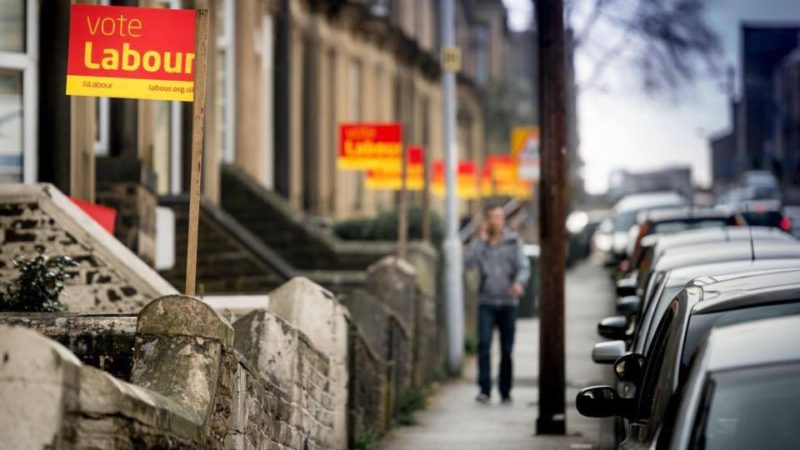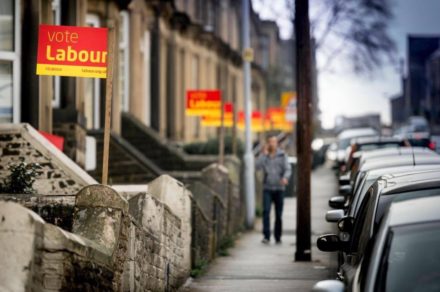

Winning in First Past the Post elections is very little to do with the national vote share and all about winning the key marginal seats. We know this from the US Presidential election where Hilary Clinton got nearly three million more votes than Donald Trump but lost to him because he took the Electoral College votes of the key swing states by narrow margins. We know it from the 2015 General Election where Ed Miliband increased Labour’s vote share by 1.5 per cent but our number of seats fell by 26.
Political parties in First Past the Post elections can dramatically affect their seat totals by effective targeting. Some of this is done at a national and regional level by deploying central phone banks, direct mail shots, billboard and local newspaper advertising, and visits by the leader and other newsworthy key campaigners to target seats where they will make the most difference to the outcome. But activists can also play a key part by moving from seats that are safe or unwinnable to the ones where a small number of votes will determine the outcome and extra hands to canvass, deliver leaflets and get out the vote will make the most difference. This is particularly important for Labour whose activists disproportionately live in inner-city areas and university towns with larger number of students, BAME residents and graduates, and are not always effectively distributed in the seats where they can make most difference.
In recent elections, most notably 1997 and 2015, Labour’s Key Seat strategy has been widely known among activists (and has leaked, perhaps deliberately, to the media), there has been a formal pattern of twinning other seats with key marginals over several years, and the national and regional parties have given clear direction over where people should go and help to have most impact.
In this General Election, there is a less clear steer from the party about where help is needed, partly because the snap election meant there hasn’t been time to develop a targeting strategy, partly because of the sheer range of the number of seats the Tories might threaten us in, and partly to avoid giving the media a story about our strategy being defensive.
This has left many activists wondering where they should go to be most helpful.
Momentum has to its credit stepped into the breach with a web tool My Nearest Marginal that matches activist to marginal seats but it is a bit hit and miss in that it only includes at the time of writing 35 constituencies, 13 of which are attack seats it seems to be suggesting can be gained from the Tories. The small number of seats listed so far can cause some odd search results – enter a home postcode in Bristol and you will be directed to Telford in Shropshire or Gower in Wales, not to one of Bristol’s three defensive marginal seats.
There is clearly a demand from activists to know where the battlefield actually is, so I thought I had better issue some guidance.
I’ve taken a statistical approach and combined the baseline of the results in each constituency from 2015 with the latest regional polling by YouGov which helps deal with the fact that swing will be different in different regions. Swing from Lab to Con varies dramatically according to YouGov, from just 0.5 per cent in the South West to 10 per cent in the North East. All the pollsters are saying roughly the same thing nationally (a Tory lead of 16-18 per cent) but if you think they are all, or YouGov is specifically, over-pessimistic about Labour’s chances, you should go and campaign in the most marginal seats at the start of the regional list, if you are more pessimistic yourself go to the notionally safest seats listed.
Here are the seats that the polls suggest constitute the battlefield in each region – those that would currently fall on a uniform regional swing, and in italics those that would be on the edge of falling. It is the seats immediately on either side of the current swing figure that are most affected by additional campaigning, but this changes if Labour’s position nationally improves during the final weeks of the campaign. I have made separate calculations regarding the tiny number of Lab vs LD marginals. A swing of 1 per cent sees a seat with a 2 per cent majority fall etc. All majorities are over Con unless indicated.
East – swing of 5 per cent from Lab to Con
Cambridge 1.1 per cent majority over LD
Luton South 13.5 per cent
Norwich South 15.8 per cent
East Midlands – swing of 7 per cent from Lab to Con
North East Derbyshire 3.9 per cent majority
Gedling 6.2 per cent
Mansfield 11.2 per cent
Nottingham South 15.9 per cent
Bassetlaw 17.9 per cent
Ashfield 18.6 per cent
London – swing of 2 per cent from Lab to Con, 4.5 per cent from Lab to LD
Ealing Central & Acton 0.5 per cent majority
Brentford & Isleworth 0.9 per cent
Ilford North 1.2 per cent
Hampstead & Kilburn 2.1 per cent
Enfield North 2.3 per cent
Harrow West 4.8 per cent
Westminster North 5 per cent
Tooting 5.3 per cent
Eltham 6.2 per cent
Bermondsey & Old Southwark 8.8 per cent over LD
North East – swing of 10 per cent from Lab to Con
Middlesbrough South & Cleveland East 4.9 per cent majority
Hartlepool 7.6 per cent over UKIP, 15.9 per cent over Con
Darlington 7.7 per cent
Bishop Auckland 8.9 per cent
Tynemouth 15.4 per cent
Sedgefield 17.7 per cent
North West – swing of 6.5 per cent from Lab to Con
City of Chester 0.1 per cent majority
Wirral West 0.9 per cent
Barrow & Furness 1.8 per cent
Lancaster & Fleetwood 3.1 per cent
Copeland 6.5 per cent (already lost in by-election)
Blackpool South 8 per cent
Chorley 8.8 per cent
Hyndburn 10.2 per cent
Bolton North East 10.2 per cent
Bury South 10.5 per cent
Wirral South 11 per cent
Workington 12.2 per cent
Oldham East & Saddleworth 13.5 per cent
Ellesmere Port & Neston 13.5 per cent
Worsley & Eccles South 14.1 per cent
Stalybridge & Hyde 16.3 per cent
Scotland – swing of 9.5 per cent from Lab to Con but 1.5 per cent from SNP to Lab
Edinburgh South is the only Labour held seat in Scotland with a lead of 5.3 per cent over the SNP and 22.4 per cent over the Tories.
The SNP-held seats in Scotland where Labour is most competitive against the SNP are probably East Renfrewshire, East Lothian, Kirkcaldy & Cowdenbeath and West Dunbartonshire.
South East – swing of 2 per cent from Lab to Con
Hove 2.4 per cent majority
Southampton Test 8.8 per cent
Slough 15.2 per cent
South West – swing of 0.5 per cent from Lab to Con
There are no Labour seats that would fall on this swing, however if the swing is higher in the urban areas, these are the only Labour seats in the region, and in practice all of them are under severe opposition pressure:
Bristol East 8.6 per cent
Bristol West 8.9 per cent over Green
Exeter 13.3 per cent
Bristol South 14.1 per cent
Wales – swing of 8 per cent from Lab to Con
Ynys Mon 0.6 per cent majority over Plaid Cymru, 9.9 per cent over Con
Bridgend 4.9 per cent
Wrexham 5.6 per cent
Clwyd South 6.8 per cent
Delyn 7.8 per cent
Alyn & Deeside 8.1 per cent
Newport West 8.6 per cent
Newport East 13.4 per cent
Cardiff West 15.5 per cent
Cardiff South & Penarth 16 per cent
Swansea West 20 per cent
West Midlands – swing of 7 per cent from Lab to Con
Newcastle-under-Lyme 1.5 per cent majority
Wolverhampton South West 2 per cent
Walsall North 5.2 per cent
Birmingham Northfield 5.9 per cent
Stoke-on-Trent South 6.2 per cent
Birmingham Edgbaston 6.5 per cent
Coventry South 7.3 per cent
Coventry North West 10 per cent
Dudley North 11 per cent
Stoke-on-Trent North 12.5 per cent
Walsall South 14.4 per cent
Birmingham Erdington 14.8 per cent
Wolverhampton North East 16.2 per cent
Stoke-on-Trent Central 16.6 per cent
Birmingham Selly Oak 18.7 per cent
Yorkshire and Humberside – swing of 5.5 per cent from Lab to Con
Halifax 1 per cent majority
Dewsbury 2.7 per cent
Wakefield 6.1 per cent
Scunthorpe 8.5 per cent
Batley & Spen 11 per cent
Great Grimsby 13.5 per cent
York Central 14.1 per cent
Penistone & Stocksbridge 14.3 per cent
Leeds North East 15 per cent
Outside the range suggested there are some seats with exceptional local circumstances: Birmingham Yardley, Burnley (both previously Lib Dem seats where the former MP is re-standing), Rochdale where former MP Simon Danczuk is running as an independent, and Heywood & Middleton where there was a particularly strong UKIP vote in 2015.
If you want to travel to help campaign in any of these potentially marginal constituencies then take a look at the Labour Party website events section here, but instead of entering your home postcode enter a postcode from the town you want to campaign in (e.g. Google the postcode of the town hall) and it will give you a list of all the campaign sessions you can join in with. Alternatively call your Labour Party regional office to get details of campaigning in the seat you want to assist.




More from LabourList
Burnham’s popularity with members drops, but still over 50% approve – poll
‘Labour’s blind spot on rents is becoming a political liability’
Starmer: ‘My experience now as Prime Minister is of frustration’